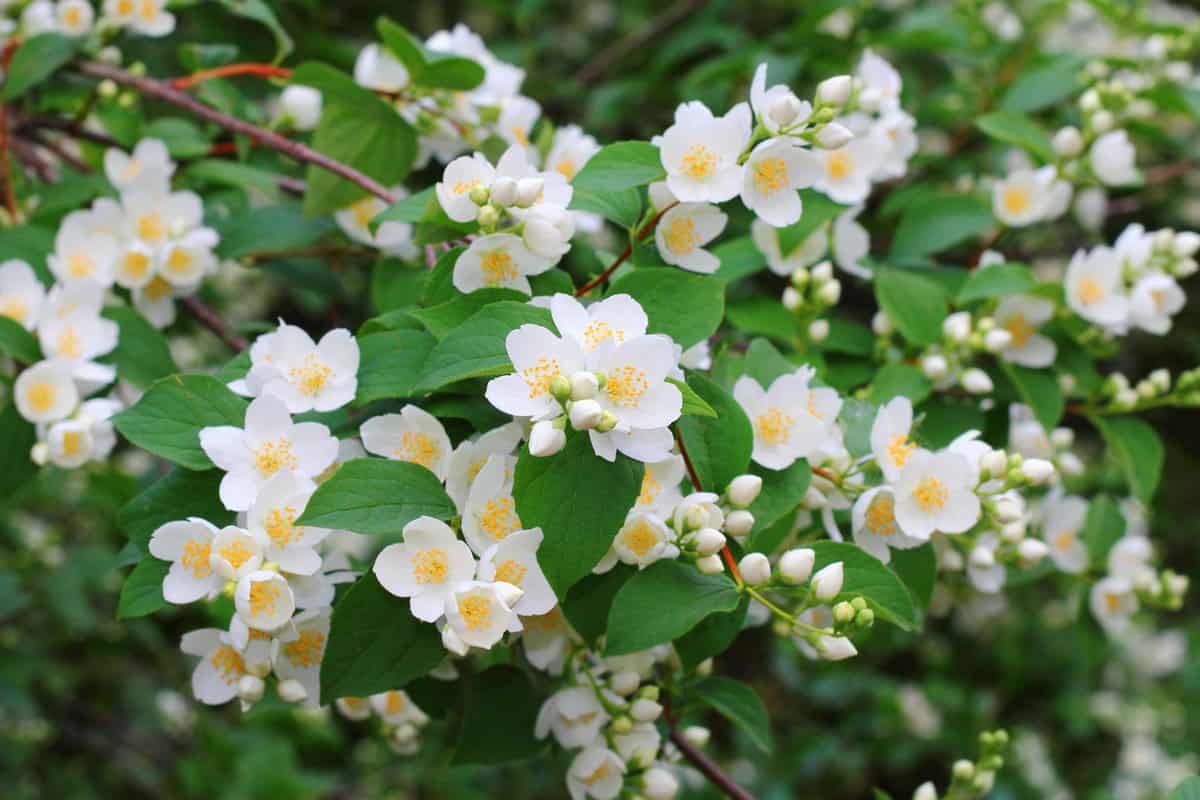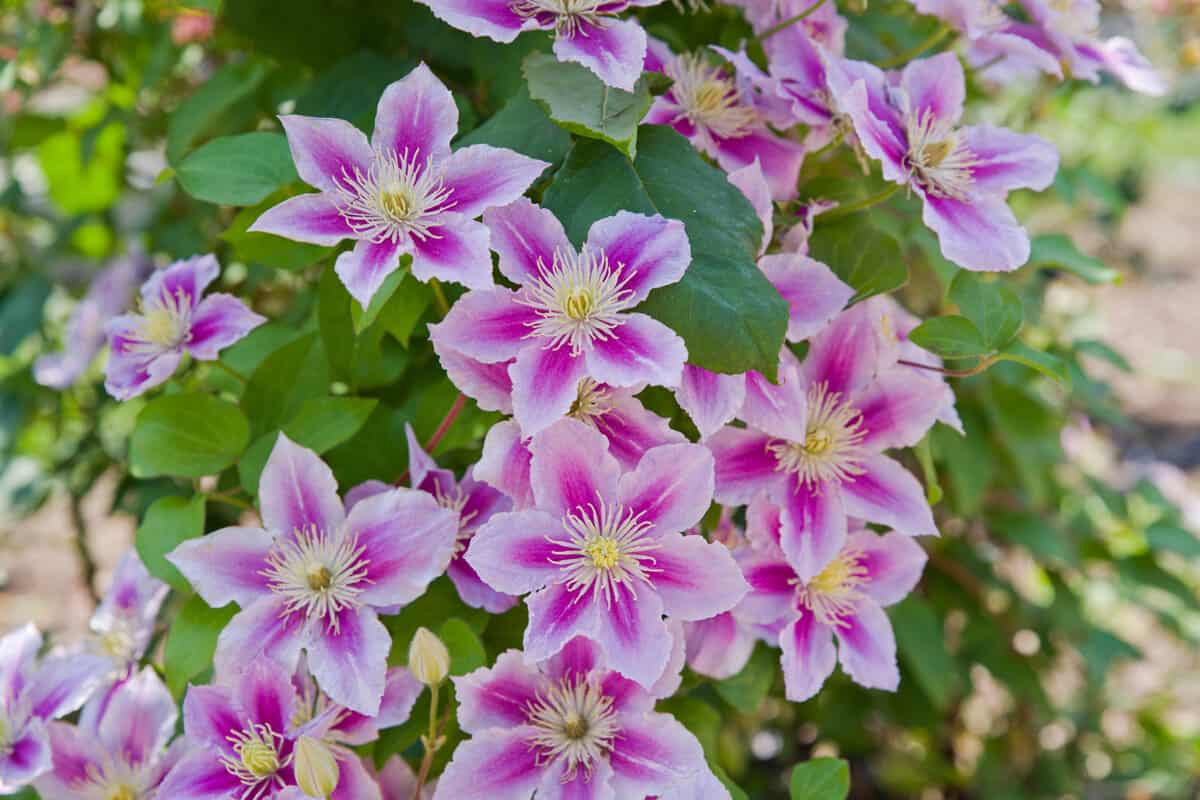Designing a garden can feel like an everlasting task if you aren't prepared. Do you have a California lilac growing in your yard and want to add more color nearby? What are some good companion plants for this beautiful species?
We'll dive into our top 11 choices throughout this article. Let's dive in!
For those with a California lilac, you have plenty of options for companion plants. Our top 11 picks for this flowering species include:
- Daffodils
- Mock Orange
- Crabapples
- Clematis
- Dogwoods
- Magnolias
- Cherries
- Hyacinth
- Peonies
- Tulips
- Daylilies
Of course, you want to try and plant something as vibrant as your California lilac, so we recommend a flowering plant/variety regardless.
As we start, we will cover all things California lilac and discuss which plants to grow nearby. Whether it's time for some spring planting or you want to add more flowers to your property, we're here to help. With that said, let's dive right into this topic below!
![Mock orange tree flower blossoms in summer, What To Plant With California Lilac [11 Companion Plants To Consider]](https://gardentabs.com/wp-content/uploads/2023/05/What-To-Plant-With-California-Lilac-11-Companion-Plants-To-Consider-2.png)
What Should You Plant Near California Lilac?

In general, you want to continue a colorful and fragrant trend near a California lilac. Considering your flower will be blue and fragrant, opting for other similar hues can be helpful.
However, you can also choose other bright-colored species next to a California lilac. Especially if you want your garden to grab the neighbors' attention, selecting the brightest, biggest blooming plants is wise.
Whether you want to train your lilac to grow upwards or stay close to the ground, it can't hurt to add even more color to your landscaping.
Therefore, we recommend species like magnolias, daffodils, and other cheerful flowering plants. Some gardeners also choose to add flowering trees near their California lilacs, so that's another idea.
Again, every yard is different, so this comes down to your plant preference.
1. Daffodils

First, we have daffodils next to a California lilac. These beautiful flowers are easy to grow and manage and pair nicely with the blue tone of your lilac.
Daffodils tend to grow best throughout temperate North American regions, which is the same for California lilacs. Also, these flowers need around six or more hours of the daily sun: the same as lilacs.
In addition, daffodils will grow back for a few years after you plant them, so they tend to be perennial plants versus annuals.
Dutch Master Daffodils
These daffodils come in a pack of 25 bulbs, will weigh roughly six pounds altogether, should bloom in the spring, and can grow in USDA zones 3-8.


2. Mock Orange

Next, we have a softer colored flower for your California lilac with the mock orange. Generally, these fragrant white flowering shrubs will be easy to care for, and they love the sun.
Moreover, these flowers are native to North America and will grow in most of the same regions as a California lilac. These shrubs are also somewhat tiny, often reaching a mature size of 12 inches tall/wide.
So, if you have a larger California lilac and don't want to overpower it, this could be the plant for you. Mock orange is also a deciduous species, like many lilacs, so it will lose its foliage in the winter.
3. Crabapples

Sticking to a soft-colored plant for California lilac, we have a flowering crabapple. Generally, this species of ornamental fruit trees/shrubs will grow alongside other plants without issues, which is good to know.
You can usually expect a crabapple tree or bush to bloom through the spring, which is also close to a California lilac's flowering period.
In addition, crabapples are low maintenance and produce small fruits you can eat, although they aren't quite as tasty as full-sized apples.
This plant is also perfect for anyone wanting a larger option alongside their lilac, as it grows to nearly 20 feet tall if it's a full-sized variety.
4. Clematis

For those wanting a more vivid flowering plant near their California lilac, we recommend a clematis. Typically, this species (also known as a 'leather flower') will do best in the full sun and doesn't mind neighbors close by.
Clematis is a genus of around 300 species within the buttercup family, so there are endless colors/sizes to choose from.
One interesting feature of this plant is its larger-sized blooms. Specifically, a clematis flower will have between six and seven petals and measure 5-6 inches across.
So, this species is worth trying if you want something eye-catching besides your California lilac.
Clematis 'The President' - Starter Plants
This live clematis plant will come in a four-inch pot, has purple/blue flowers, should bloom in the summer, needs well-drained soil, and comes in a few bundle options.


Follow this link to view it on Amazon.
5. Dogwoods

Coming in fifth, we have a dogwood flowering tree or shrub for your California lilac. These plants will generally be woodsy and produce white or pink blooms in the spring.
Furthermore, some dogwood varieties stay smaller and shrub-like, so you don't have to plant a tree in your garden if you don't want to.
This species will also thrive in full sun, which is the same as California lilac. However, you will need to water a dogwood more frequently than a lilac, so that's something to keep in mind.
6. Magnolias

Following a similar color scheme, we have magnolias for your California lilac companion. An interesting fact about these trees/shrubs is that they're one of the oldest in existence.
Furthermore, magnolias don't technically have petals but instead have petal-like tepals.
Your magnolia will also produce a sweet aroma and large flowers throughout the spring and summer. In addition, these trees/shrubs need full sun to grow and bloom, the same for California lilacs.
You'll also find plenty of magnolias throughout the Southern United States, but they can grow in most North American climates.
Perfect Plants Little Gem Magnolia
This live magnolia plant will come 1-2 feet tall, should bloom in the summer, needs full sun exposure, comes from a small business, and comes in a few sizes.


Check out this live plant on Amazon.
7. Cherries

Sticking with sweet-smelling trees, we have a flowering cherry tree for your California lilac.
Considering a California lilac will produce eye-catching blooms during the spring/summer, planting a cherry tree nearby can be the perfect pairing.
Generally, this species will require four or more hours of direct sunlight daily to grow, while California lilac prefers six plus.
Again, if you're somewhere with intense sun throughout the year, both a California lilac and a cherry tree will benefit from shade during the afternoon.
A cherry tree will also reach a mature height of between 15 and 25 feet, so these can become quite extensive. However, cherry trees aren't invasive, so your lilac shouldn't be affected.
8. Hyacinth

Coming in eighth, we have a small, bright-colored perennial flower for your California lilac. Usually, hyacinth plants will bloom in the springtime, often having bulbous flowers.
These flowers are incredibly fragrant and can be pink, purple, and white, so they'll look great next to a lilac bush/tree. Like lilacs, hyacinths also don't need much watering.
They prefer less moisture in their soil throughout the year and enjoy full sun to partial shade. Another benefit of these perennials is that they tend to self-spread, so you'll often see many starts to sprout near each other.
Mixed Color Hyacinth Seeds
This pack of 500 hyacinth seeds will be multi-colored, can be grown inside or outdoors, should bloom in the summer, and require well-drained soil.


Check out these flower seeds on Amazon.
9. Peonies

Next up, we have a fan favorite with peonies for beside your California lilac. Generally, this flowering plant will be easy to manage and prefers six hours of daily sunlight.
Furthermore, peonies are perennial, meaning they'll return next year and continue to bloom. One thing to remember about this species is that they don't like strong winds.
So, planting your peonies near a California lilac could offer this protection and give your garden plenty of additional color/aroma.
Peonies also tend to thrive in USDA zones 2-8, which is a large portion of the United States. You'll also notice your peony produces large, fluffy flowers after its first year, so you won't need to wait long.
10. Tulips

Sticking to perennial flowers, we have tulips near a California lilac. Growing tulips close to another plant won't be an issue, as they have shallow root systems.
Furthermore, these plants produce red, pink, yellow, or white blooms, which all pair nicely with the blue tones of a California lilac.
You can also expect a tulip to live for around 2-5 years on average, which is pretty good for a bulbous flower. Climate is one of the most critical factors for a tulip's health, so try to grow yours somewhere that doesn't get too cold or extremely hot.
11. Daylilies

Last on the list, we have daylilies beside a California lilac. Daylilies are a favorite among gardeners because they're low maintenance and come back year after year.
Besides being drought-tolerant, daylilies are virtually disease- and pest-free, which can make a huge difference for them and the plants nearby.
Daylilies also produce gorgeous orange/yellow flowers, making them a great choice for a vibrant landscape.
To Finish
![Beetles pollinate orange daylilies on the flowerbed - What To Plant With California Lilac [11 Companion Plants To Consider]](https://gardentabs.com/wp-content/uploads/2022/08/Beetles-pollinate-orange-daylilies-on-the-flowerbed-What-To-Plant-With-California-Lilac-11-Companion-Plants-T.png)
Whether you want to add more flowers to your garden or need an idea for your California lilac, it's always good to find a companion plant.
We found that there are plenty of options for a California lilac, including tulips, magnolias, clematis, crabapples, and more.
Generally, flowering shrubs and trees will be best for a lilac companion, as they will produce fragrant flowers. This can make a huge difference in your yard and get all the neighbors talking.
Made it to the end? Check out these helpful related posts below!
When To Cut Back Lilac Bushes (And How To Do That)?

![What To Plant With California Lilac [11 Companion Plants To Consider]](https://gardentabs.com/wp-content/uploads/2023/05/What-To-Plant-With-California-Lilac-11-Companion-Plants-To-Consider-1.png)
![What To Plant With California Lilac [11 Companion Plants To Consider]](https://gardentabs.com/wp-content/uploads/2023/05/What-To-Plant-With-California-Lilac-11-Companion-Plants-To-Consider-683x1024.png)